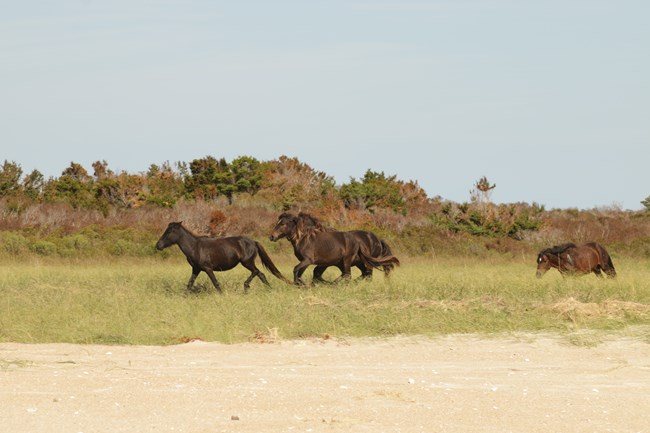
NPS Photo/Sabrina Godin Ah, camping at the beach. Sea, sand, sun, brilliant sunsets, and dark skies. Swimming, surfing, fishing, clamming, crabbing and evening campfires. These are the things that memories are made of. The following information will ensure that your camping trip to the seashore is a safe and enjoyable one. Vehicle Camping I Tent Camping I North Core Banks Camping I Vehicle CampingVisitors are welcome to camp with their vehicles, but vehicles, including any style trailer or pop-up camper, or vehicles with a rooftop tent or truck bed camper, must be kept on the oceanside beach seaward of the primary dunes, not between or on top of dunes. In addition, no vehicle is allowed to camp on the trail behind the dunes known as the "back road" unless there is a designated signed spot. Drivers must follow the regulations for off-road vehicles (ORVs) outlined on the Beach Driving section of the website and must have an ORV Beach Driving Permit. Special use permits for Long-Term parking are required for vehicles located in long-term parking lots. No vehicle may be left unattended for over 24 hours without a permit.Tent CampingTent campers may set up among, but not on, the dunes just behind the ocean beach as well as on the sound-side of the island. For adequate shelter, a tent that has insect netting and is designed to withstand strong winds is recommended. To anchor the tent properly, use stakes that are about one foot in length. Standard stakes may not hold in the sand under high wind conditions.Areas Closed to Camping

NPS Photo North Core Banks Camping22 miles of primitive beach is available for camping for vehicles and tents.Amenities:

NPS Photo/Sabrina Godin South Core Banks Camping24 miles of primitive beach camping for vehicles and tent camping.Amenities:

NPS Photo/Nate Toering Shackleford Banks Camping8 miles of primitive beaches available to tent campers Amenities:
CampfiresOpen campfires can only be built below the high tide line (in damp sand) and be no wider than 3 feet in diameter. Bonfires are not allowed. Remember that you are the fire department when you are on the island, and you are responsible for the actions of your fire.Visitors may want to check the tide predictions in advance to determine when they can build fires. Loose dead wood on the ground within 200 feet of the shore may be used for campfires. Wood from shipwrecks or historical or archeological sites and wood from standing trees may not be used. Campers are encouraged to bring their own wood because the amount of wood available in the park is extremely limited. Cooking receptacles which are enclosed on the bottom and sides, such as grills, are permitted in all areas of the park except for Portsmouth Village, the Cape Lookout Village, on cabin or house porches, and wooden structures (including boardwalks and shade shelters) associated with the lighthouse. These grills should be used carefully and with consideration for the surrounding vegetation. All food waste and trash must be taken out of the park: there is no garbage pick-up. Frequently Asked Questions Hammocks may only be used if they can be made free-standing. Hammocks may not be hung in shade shelters or attached to other structures or strung between trees.
Sunscreen and insect repellant should be carried with you. Biting insects such as mosquitoes, greenhead flies, ants, deerflies, and gnats can be found throughout the seashore during the months of May through October. Chiggers and ticks can also be found.
Sturdy walking shoes are recommended for walking in the soft sand. There are no camp stores within the park. Campers should bring all the food, fresh water, and firewood they will need during their visit. Firewood is not available to be purchased on the island. When tent camping, very long tent stakes or corkscrew style stakes are preferable. The short tent stakes are not ideal for soft sand and may come loose. In areas where there is not a restroom, human waste should be buried above the high tide line in a location where other people will be unlikely to walk or camp. With a small trowel, dig a hole about 6-8 inches deep and 4-6 inches in diameter. Cover the cathole when finished. Using this method minimizes the possibility of spreading diseases.
Weather conditions can change rapidly on the islands. Be aware of the predicted tides. Information and weather predictions can be found on the Weather page.
Park and federal regulations on camping and other activities can be found in the Rules and Regulations section of the Laws and Policies page.
Kayakers and canoers who are camping in the park are asked to leave a float plan with a responsible family member or friend who will see you within 24 hours of your planned return date. More information is available on the Kayaking and Canoeing page.
Pets are required to be on leashes at all times. More information about pet regulations can be found on the Pets page.
Check out the private campgrounds listed on the Crystal Coast Tourism Authority's website and the campgrounds in the Croatan National Forest.
|
An official website of the United States government
Here's how you know
Official websites use .gov
A
.gov website belongs to an official government
organization in the United States.
Secure .gov websites use HTTPS
A
lock (
) or https:// means you've safely connected to
the .gov website. Share sensitive information only on official,
secure websites.
